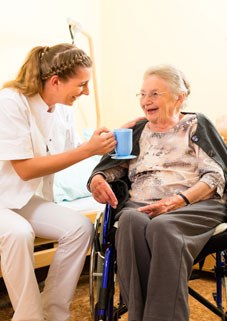Advice: Preventing Pressure Sores
 Older people who spend a lot of time sitting or lying down, and whose skin has become fragile due to ageing, can quickly develop pressure sores, which may take a long time to heal.
Older people who spend a lot of time sitting or lying down, and whose skin has become fragile due to ageing, can quickly develop pressure sores, which may take a long time to heal.
Pressure sores are painful skin ulcers that form when constant pressure on a part of the body shuts down the blood vessels feeding that area of skin. Areas vulnerable to pressure sores include the lower back and buttocks, and bony protruding areas such as shoulders, hips, knees, heels, and ankles.
Damage first appears on the skin surface as a red or dark patch. As the pressure sore progresses, the skin will break down to form blisters, dead skin, and ultimately infect tissues, bones, and joints.
Skin damage can result in as little as two hours of sustained pressure. It can also worsen with friction and moisture. You can treat pressure sores at home by relieving pressure, cleaning sores, and using appropriate dressings.
It is always advisable to see your GP or visiting nurse if you believe a pressure sore is developing, as surface damage is just the tip of the iceberg (the real damage happens under the skin).
Serious sores can require treatment or surgery, and increase the risk of major infection – even (rarely) death.
You can do a lot to prevent pressure sores. The most important step is to help your family member change position frequently. Movement can help to reduce pressure sores.
After bathing, use a cornstarch-based powder to keep areas dry without dehydrating the skin. Check skin daily for signs of redness and discolouration.
If your family member does develop a pressure sore, seek medical advice about how to change dressings and keep the sore clean. This may need to be done by a health professional.
Infection is a real risk and can spread to other parts of the body.
Signs of infection in a pressure sore include fever or chills, rapid heartbeat, general weakness, and confusion. There may also be swelling or tenderness around the area; yellow or green pus; odour; and warmth or redness.
Contact your GP if you observe any of these warning signs.
Risk factors for pressure sores
- Age
- Immobility
- Incontinence
- Poor diet and/or poor hydration (not enough liquids)
- Disorders that slow healing such as diabetes
- Conditions like dementia, which lessen mental awareness and feelings of discomfort in prolonged body positions
- Medications, especially sedatives
Warning signs
- Discoloured, torn or swollen skin, especially over bony areas
- Skin warmth, swelling, odour, pus (all signs of infection)
- Darkened or reddened skin that doesn’t turn white when firmly pressed
- Skin loss that might appear as an abrasion, blister, or shallow crater
- Full skin loss into underlying tissue
- Full skin loss beyond underlying tissue into muscle and bone (this is the most serious type of pressure sore)
Seek professional help immediately for sores that are getting worse, not healing, or show signs of infection.
Helpful Tips
- Dry thoroughly after showering, bathing, or washing.
- Use soft pillows to prop your family member up in bed, under their buttocks while sitting up in bed, or under their knees to elevate their legs a bit.
- Consider investing in an ‘egg crate’ or sheepskin mattress underlay, which can reduce skin pressure.
- There are also special products for bony areas to minimise the risk of pressure sores; these are affordable and also keep joints warm during cold months. View product options at your nearest Disability Information Centre.
Photo: Shutterstock.com